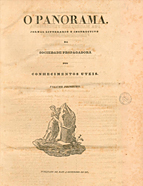

................................
It is hardly surprising that history, in its many forms—such as the history of art, literature, archaeology, monuments, figures, and chronologies—was the area most frequently highlighted in the newspaper. This emphasis reflected the essence of Romantic sensibility, which often idealised the Middle Ages (E.G. Dias, A construção da História Medieval na Imprensa Periódica... [The Construction of Mediaeval History in the Periodical Press]). However, the historical references were not purely descriptive. They also included a strong advocacy for the preservation of heritage and "places of memory" against neglect and vandalism. This theme was notably championed by Herculano in articles such as A Arquitectura Gótica [Gothic Architecture] (Issue 1, p. 2, 1837). He wrote about the threat of vandalism with a striking observation: "Vandalism is courteous, civil, and friendly." As long as it does not touch any monument, it is the most peaceful entity in the world" ("Monumentos II" [Monuments II], Issue 70, p. 275, 1838). In this same article, Alexandre Herculano argued that the defence of these monuments had a productive aspect, not only due to their symbolic significance and identity but also because they could serve as an early form of tourism (Idem, p. 277).
A substantial part of the historical memory mobilised by the liberals was integrative. Despite the break with absolutism, it ensured continuity, where the past, present, and future converged —shaped by revolutions and civil war, especially in politically unstable times. This is how history became a decisive concept in O Panorama . It was not merely used in a playful or publicising manner but was intertwined with literature and the arts in a pragmatic—and programmatic—sense, aimed at the cultural development of citizens. As the editor António de Oliveira Marreca expressed in the 1840s, O Panorama was "the first newspaper that, in addition to spreading ideas of material utility, worked to revive the feeling of the old national energy and glory, a feeling that had been dampened and almost worn out by long years of misfortune and discouragement. Without its revival, no regeneration is possible, since we cannot consider the regeneration of the dignity of man and citizen as a starting point. (...) O Panorama has tried to incorporate the desires and hopes of the future with the nostalgia and traditions of the beautiful and grandiose that ennobled this good land of ours in ancient times. We are convinced that—on the moral side—this is the greatest service the popular press can do for the nation, and O Panorama has done exactly that" ("Introdução" [Introduction], Issue 106, p. 1, 1844). Against the backdrop of a (constructed) historical memory, the newspaper promoted the use of historical examples, reinforcing an evolving belief in the potential of the Portuguese people.
This work is financed by national funds through FCT - Foundation for Science and Technology, I.P, in the scope of the projects UIDB/04311/2020 and UIDP/04311/2020.
